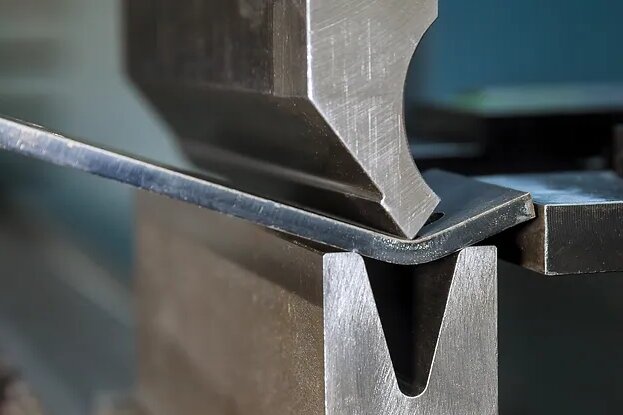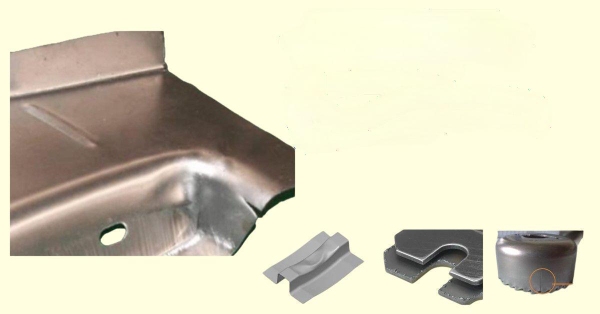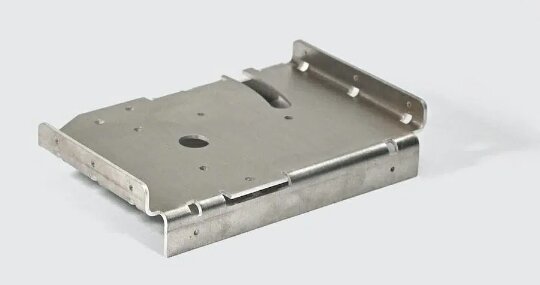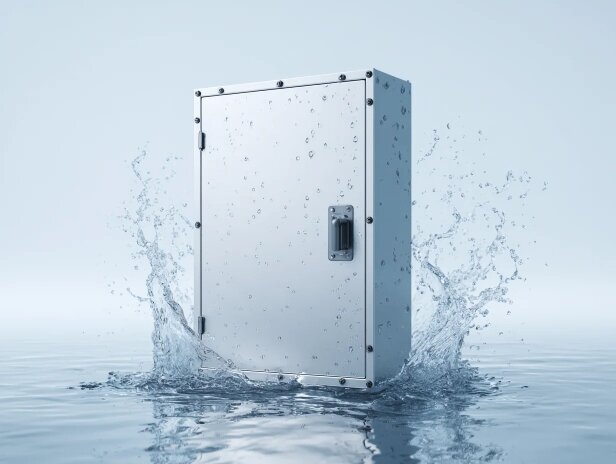Sheet metal bending looks straightforward, but the metal goes through a complex mix of tension and compression. If these forces shift even slightly, the part no longer holds its intended shape.
Deformation happens for predictable reasons. Understanding how stress moves through the sheet gives designers and operators better control of the process. This knowledge helps them prevent warping, bowing, twisting, and dimensional errors before the parts reach the production floor.

Common Deformation Patterns
Different types of distortion come from different stress imbalances. Recognizing the pattern makes it easier to trace the root cause.
Déformation et torsion
Twist develops when one side of the bend stretches more than the other. Even a 0.1 mm stretch difference turns into several degrees of twist across a 300–600 mm panel. Thin sheets under 1.5 mm react most strongly because they lack stiffness.
Operators often see this when the part rocks on a flat table or when an extended flange refuses to sit straight during assembly.
Oil-Canning and Surface Waves
Wide panels lose internal tension during bending and form soft ripples. This shows up most often in 1.0–1.5 mm material because it flexes easily.
A light press of a finger can cause the panel to “pop” in and out. This instability comes from uneven stress released across the panel after forming.
Flange Collapse on Short Bends
A flange needs enough length to resist the punch force. When the flange is shorter than the V-die opening, it cannot stay straight.
For example, bending 1.2 mm steel with an 8 mm die requires a flange of at least 8–10 mm. Anything shorter will fold outward or bulge, no matter how skilled the operator is.
Hole and Feature Distortion Near Bend Lines
Bending stretches the bend zone by 8–15%. If a hole sits inside that zone, the metal around it stretches unevenly.
Round holes become oval. Slots shift sideways. Tabs move by 0.2–0.6 mm depending on the material and thickness. Soft metals like aluminum deform even faster.

Causes of Deformation in Sheet Metal Bending
Most sheet metal bending defects aren’t caused by a single mistake. They come from interactions between design, material, and the bending process.
Design Factors That Amplify Stress
Small decisions can dramatically increase localized strain:
- Holes or slots too close to bends weaken the bend zone.
- Flanges shorter than the die opening cannot stabilize the bend.
- Tight radii overload the outer surface and cause stretching or cracking.
- Unbalanced geometries bend toward the weaker side.
A simple change like moving a feature 1–2 mm farther away can eliminate deformation.
Material Behavior That Drives Deformation
Different metals bend differently:
- Thin material exaggerates minor inconsistencies.
- Aluminum stretches easily and shows more waviness.
- Stainless steel needs a higher force and springs back harder.
- Grain direction changes how the metal tolerates tension.
A grain orientation error alone can increase crack risk by 20–40%.
Process Conditions That Influence Accuracy
The bending setup strongly affects how the material moves:
- Poor bending sequence traps stress in corners.
- Worn tools shift the bend line by 0.05–0.10 mm.
- Unsupported flanges sag under their own weight.
- Heat from welding or marking causes delayed distortion.
- Uneven tonnage across the brake creates tapered angles.
Even with perfect design and material, an unstable process can twist a panel beyond tolerance.
Design Strategies to Prevent Deformation
Good design reduces stress before bending. When geometry, spacing, and radii match how metal behaves in real forming conditions, the part stays stable and consistent.
Use Bend Radii That Fit the Material’s Limits
Metal bends cleanly when the radius keeps strain below the material’s safe elastic-plastic range. Too tight a radius compresses the inside too sharply and stretches the outside beyond what the sheet can absorb.
Practical radius guidelines used in production:
| Matériel | Minimum Inside Radius | Notes |
|---|---|---|
| Acier doux | 1.0 × thickness | Stable forming, low springback |
| Acier inoxydable | 1.5 × thickness | Higher force, stronger rebound |
| Aluminium 5052 | 1.5–2.0 × thickness | Soft, prone to surface dents |
| Aluminium 6061-T6 | 2.0 × thickness or more | Brittle in T6 temper, cracking risk |
When the radius is too small:
- 0.8–1.0 mm steel forms inside wrinkles and pulls the outside grain apart
- Aluminum enlarges strain, causing surface waviness
- Stainless steel develops micro-cracks that only appear after bending
- Dos d'âne increases by 0.5–1.5° depending on hardness
A slightly larger radius stabilizes the bend, reduces pressure, and makes angles easier to control in mass production.
Place Holes, Slots, and Cutouts Far Enough From the Bend Line
Features weaken the bend zone. When the punch forces the metal to rotate, any nearby cutout becomes the “stretch point,” causing oval holes or shifted positions.
Industry-tested spacing rules:
- Minimum spacing: 2 × thickness
- Recommended for thin sheet (≤1.0 mm): 3 × thickness
- For large holes: hole diameter + thickness
- For slots or notches: spacing ≥ slot width × 2
Common distortion amounts in real production:
- Holes shift 0.2–0.6 mm
- Slots elongate by 5–12%
- Tabs drift by 0.15–0.30 mm
If spacing cannot be increased, bend relief cutouts or modified bend sequences help absorb stress.
Keep the Flange Length Long Enough to Support the Bend
Short flanges collapse, curl, or ripple because they cannot support pressure from the punch.
Minimum flange lengths based on V-die size:
| Sheet Thickness | Typical V-Die Opening | Longueur minimale de la bride |
|---|---|---|
| 1.0 mm | 8 mm | 8–10 mm |
| 1.2–1.5 mm | 10–12 mm | 10–14 mm |
| 2.0 mm | 16 mm | 16–18 mm |
Flanges shorter than the die width almost always deform. Increasing the flange by 1–2 mm or using a smaller die dramatically improves stability.
Add Bend Reliefs to Reduce Tearing and Corner Distortion
Reliefs give the sheet a place to expand and contract. They protect corner zones where material fights against two opposing forces.
Recommended relief dimensions:
- Width: ≥ sheet thickness
- Profondeur: ≥ radius + thickness
- Shape: rectangular or rounded for stainless/aluminum
Benefits seen in production:
- Cleaner corner edges
- Less tearing in high-strength steel
- Prevents V-shaped puckering on tight 90° bends
- Reduces cosmetic defects on brushed aluminum
Balance the Geometry to Avoid One-Sided Stretching
Metal bends toward the weaker side. Large cutouts, long slots, or asymmetric flanges create uneven stiffness and cause twist.
Designers can improve stiffness by:
- Mirroring cutouts on both sides when possible
- Adding ribs, hems, return bends, or small flanges
- Increasing wall thickness in high-stress regions
- Adding corner gussets to large U-shaped parts
A stiffness imbalance as small as 5% can twist a 350–400 mm channel enough to cause assembly gaps.
Plan a Bend Sequence That Lets the Metal Move Naturally
A controlled sequence allows the sheet to rotate freely without trapping internal stress.
General sequencing principles used in production shops:
- Bend large angles first
- Do small flanges last
- Avoid forming boxed shapes too early
- Leave the sheet as flat as possible for as long as possible
- Support the part during later bends to avoid rotation drift
A stable bend sequence often reduces twist by 30–50% even without changing design.

Sélection et préparation des matériaux
Material controls how the metal behaves under stress. Choosing the right grade, thickness, and grain direction makes bending more predictable and reduces the need for heavy compensation.
Select the Material Based on the Required Bend Performance
Different materials carry different risks:
- Acier doux : easy forming, low springback, suitable for complex multi-bend shapes
- Aluminum 5052: good bendability, but stretches easily
- Aluminum 6061-T6: strong, stiff, but cracks on tight bends
- Stainless 304: strong springback and higher tonnage demand
- High-Strength Steel: sensitive to radius and prone to angle drift
When a part requires multiple bends close to each other, mild steel or 5052 aluminum generally produces the most stable results.
Choose a Thickness That Matches the Stiffness Requirements
Thin sheets deform quickly. They are light and cost-efficient but need stricter design control.
Typical thresholds where deformation increases sharply:
- Steel below 1.2 mm
- Aluminum below 1.5 mm
- Stainless below 1.0 mm
Increasing thickness by even 0.2–0.3 mm can reduce twist by up to 40% in real production.
Pick Grain Direction That Reduces Crack Risk and Controls Springback
Grain direction influences stretching during bending.
Effects observed in production:
- Bending across grain increases crack risk by 20–40%
- Bending with the grain reduces cracking but increases springback by 1–2°
- Aluminum shows more grain sensitivity than steel
- Stainless shows substantial grain-dependent springback changes
Designers often rotate flat patterns to align critical bends with safer grain orientation.
Use Material With Consistent Thickness and Hardness
Variations in sheet quality change how much the metal springs back or resists bending.
Typical material tolerance ranges:
- Thickness: ±0.03–0.05 mm
- Hardness (HB): ±10–15
- Chemical composition variation can affect springback by 0.5–1.0°
Requesting a narrow tolerance class or using material from the same coil reduces angle drift across batches.
Consider Stress Relief or Pre-Bending for Sensitive Alloys
Some materials contain residual stress from rouler, cutting, or perforation. These stresses release unpredictably during bending.
Useful practices:
- Light annealing for aluminum 5052/6061
- Stress-relief heat treatment for high-strength steels
- Small trial bends to measure springback before mass production
- Straight-line leveling for large panels to reduce internal tension
These steps help stabilize thin or heat-treated parts before forming.
Tooling and Support Methods
Tooling defines how the press brake transfers force into the sheet. When tooling is matched correctly to the material and the bend geometry, deformation drops sharply and repeatability improves.
Choose Punches and Dies That Fit the Material and Radius Requirements
Punch radius and V-die width determine the strain path of the metal. A mismatch increases both material stress and springback variation.
Industry practice:
- V-opening: 6–12 × material thickness1.0 mm steel → 8–10 mm V-die
- 2.0 mm steel → 16–20 mm V-die
- Punch tip radius: Mild steel: R = 0.6–1.0 mm
- Stainless: R = 1.0–1.5 mm
- Aluminum: R = 1.2–2.0 mm
Performance impact:
- Correct die opening improves angle repeatability to ±0.5° in air bending
- Bottoming typically improves to ±0.3°
- Coining delivers ±0.2° but increases tonnage by 3–5× and accelerates tool wear
Oversized dies cause rounded, inconsistent angles. Undersized dies crease, wrinkle, or crack the part—especially at bend radii under 1× thickness.
Maintain a Clean, Undamaged Tool Surface
Tool marks become part of the defects. A single chip on the die ridge can shift the bend line by 0.05–0.10 mm. Thin aluminum amplifies this, showing dents even from dust or flaked coating.
Best practices include:
- Cleaning dies between batches
- Removing embedded burrs with a fine stone
- Avoiding metal-on-metal scraping during setup
- Checking punch straightness with feeler gauges
Shops bending 0.8–1.2 mm material typically inspect the tool condition every 300–500 bends. High-volume stainless work requires even closer checks due to higher pressure and friction.
Support Long or Flexible Parts to Prevent Sag and Angle Drift
Gravity affects accuracy. An extended flange will sag just a few millimeters, but on thin gauges that is enough to shift the angle by 1–2°.
Support recommendations:
- Parts longer than 300–350 mm should use support arms
- Thin aluminum (≤1.5 mm) needs back-gauge wings or two-point support
- Panels ≥600 mm wide often require adjustable front tables
When unsupported, the part rotates, forcing one side to bend deeper. The resulting taper can reach 1° difference per 300 mm of length.
Use Custom Fixtures for Unstable or Low-Stiffness Geometries
Lightweight parts, perforated panels, and narrow flanges do not sit cleanly against standard back gauges.
Custom supports solve this by:
- Providing full-surface contact
- Preventing rotation during punch engagement
- Guiding asymmetric parts into a consistent position
Fixtures are standard in HVAC panels, electronics enclosures, and thin stainless components where stiffness is low and tolerances are tight.
Conclusion
Sheet metal bends best when design, material, tooling, and process all work together. Each choice affects how the metal stretches and compresses during the bend. When those choices stay within stable limits, the part holds its shape. Angles remain close to the target. Surfaces stay flat. Holes keep their position.
Most deformation comes from a few familiar causes. Tight radii increase strain. Short flanges lose support. Holes near the bend lines distort. Thin sheet reacts strongly to minor changes. Hard materials spring back more. Tool wear, uneven force, and the wrong bending sequence add even more variation.
If you are working on a new part or trying to improve an existing design, we can help you make it bend cleanly. You can send your drawings, thickness, and material choice. We can review the design, suggest simple changes, recommend better radii, or point out risks that may cause twist or distortion.
Hey, je suis Kevin Lee

Au cours des dix dernières années, j'ai été immergé dans diverses formes de fabrication de tôles, partageant ici des idées intéressantes tirées de mes expériences dans divers ateliers.
Prendre contact

Kevin Lee
J'ai plus de dix ans d'expérience professionnelle dans la fabrication de tôles, avec une spécialisation dans la découpe au laser, le pliage, le soudage et les techniques de traitement de surface. En tant que directeur technique chez Shengen, je m'engage à résoudre des problèmes de fabrication complexes et à favoriser l'innovation et la qualité dans chaque projet.




